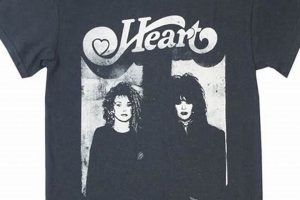Apparel featuring the likeness or imagery associated with the reggae musician Bob Marley, produced and sold in previous decades, constitutes a specific category of collectible clothing. These garments often exhibit signs of age, wear, and unique design elements that distinguish them from contemporary reproductions. An example would be a faded, single-stitch shirt displaying a portrait of the artist from his “Exodus” era, dated with a copyright from the late 1970s or early 1980s.
The significance of these items extends beyond mere clothing. They represent a tangible connection to a pivotal figure in music history and a specific cultural movement. Owning and displaying such a garment can serve as a statement of appreciation for the artist’s musical legacy and philosophical ideals. Their value is further enhanced by their scarcity, historical context, and the increasing demand within collector communities seeking authentic memorabilia from the era.
The subsequent sections will delve into the defining characteristics that differentiate genuine articles from modern imitations, exploring methods for identifying authentic examples, and discussing the factors influencing valuation within the collectors’ market. Furthermore, the article will examine the cultural impact and enduring appeal of the artist’s image on apparel, considering its continued relevance in contemporary fashion trends.
Essential Considerations for Acquiring Reggae Icon Apparel
The pursuit of authentic garments associated with the reggae musician necessitates careful evaluation to discern genuine articles from contemporary replicas. Employing the following guidelines will assist in making informed acquisition decisions.
Tip 1: Examine the Stitching. Authentic pieces typically feature single-stitch construction on the sleeves and hem, a characteristic of manufacturing processes employed in prior decades. Double-stitched seams are indicative of more recent production.
Tip 2: Assess the Fabric Composition. Older garments frequently consist of 100% cotton material, which often possesses a softer, more pliable texture resulting from age and repeated washing. Newer replicas may incorporate synthetic blends.
Tip 3: Evaluate the Print Quality. Original screen prints often exhibit a degree of cracking or fading due to age and use. High-resolution, pristine prints are typically found on contemporary reproductions.
Tip 4: Investigate the Label and Tag. The presence of a manufacturer’s label or tag provides valuable clues regarding the garment’s origin and age. Researching the specific label design and its associated time period can aid in authentication.
Tip 5: Analyze the Copyright Information. Many officially licensed garments include a copyright notice indicating the year of production and the copyright holder. Verify the legitimacy of the copyright information and its consistency with the supposed age of the apparel.
Tip 6: Scrutinize the Graphic Design. Familiarize oneself with the graphic styles and imagery prevalent during the artist’s active years. Inconsistencies in design elements or the use of modern fonts may suggest a reproduction.
Tip 7: Consider the Overall Condition. While signs of wear and tear are to be expected in garments from past decades, excessive damage or alterations may detract from the value and authenticity. Evaluate the condition in relation to the asking price and the rarity of the item.
By meticulously applying these considerations, potential buyers can significantly increase the likelihood of acquiring authentic articles, thereby securing a tangible piece of musical and cultural history.
The subsequent section will explore strategies for identifying reputable vendors and navigating the complexities of the collectors’ market to ensure a secure and rewarding acquisition experience.
1. Authenticity Verification
The authentication process is a critical determinant of value and collectibility for apparel featuring the reggae musician. The presence of verifiable indicators of age and original manufacture significantly impacts the perceived worth and desirability of the piece. Without robust authentication, the garment is essentially a reproduction, lacking the intrinsic historical and cultural connection to the artist and the era it represents. Discrepancies in stitching patterns, fabric composition, or graphic design compared to known manufacturing standards of the time are cause for concern. The failure to rigorously verify these elements can result in the acquisition of a counterfeit item, devoid of the genuine qualities sought by collectors.
An example highlighting this point involves the prevalence of reproductions bearing incorrect copyright dates. An authentic shirt produced in 1977, coinciding with the release of a particular album, should reflect that year in its copyright notice. The presence of a later copyright date, such as 1990, immediately suggests a reproduction. Similarly, discrepancies in the typeface used for the artist’s name or the concert venue on a commemorative shirt can expose inauthenticity. Thorough examination of these details, often requiring specialized knowledge or consultation with experts, is vital for ensuring the integrity of the collection.
In summary, authenticity verification functions as a fundamental pillar in the acquisition of apparel depicting the artist. The ability to accurately assess and validate the originality of a garment is essential for both individual collectors and the broader market, safeguarding against fraudulent items and preserving the historical significance associated with these pieces. The complexities inherent in this process necessitate a diligent approach and a commitment to researching manufacturing standards and design conventions of the era.
2. Rarity Assessment
Rarity assessment constitutes a critical aspect of determining the value and desirability of apparel featuring the reggae musician. The scarcity of a particular design, production era, or licensing agreement significantly impacts its appeal to collectors.
- Limited Edition Prints
Certain designs were produced in restricted quantities, often commemorating specific events or anniversaries. The scarcity of these limited-edition prints enhances their collectibility, as their availability is inherently restricted. For example, shirts produced for a particular concert tour with a clearly marked “Limited Edition” designation are considerably more valuable than mass-produced designs.
- Official vs. Bootleg Status
Garments produced under official licensing agreements with the artist or his estate are generally considered more desirable than unauthorized or “bootleg” versions. Official merchandise often reflects higher production quality and design accuracy, contributing to its long-term value. Bootleg apparel, while sometimes unique, lacks the legitimacy and provenance that collectors seek.
- Production Era Significance
The period in which the apparel was manufactured plays a crucial role in its rarity assessment. Shirts produced during the artist’s lifetime, particularly those from his peak performance years, hold greater historical significance and are often more sought after. Garments from the 1970s and early 1980s represent a more direct connection to the artist’s creative output and cultural impact.
- Condition and Preservation
The condition of the apparel significantly influences its rarity assessment. Well-preserved garments, free from excessive wear, fading, or damage, are naturally more valuable. Items with original tags and labels intact are particularly rare and command premium prices within the collectors’ market. Conversely, severely damaged or heavily altered items are less desirable, regardless of their original rarity.
These facets collectively contribute to the overall rarity assessment. The intersection of limited production, official licensing, historical era, and condition determines the position of any individual garment featuring the reggae musician within the collectors’ hierarchy, influencing its desirability and perceived value.
3. Historical Significance
Apparel featuring the reggae musician holds a tangible connection to a specific period of cultural and musical evolution. These garments, produced and distributed during the artist’s lifetime and the years immediately following, serve as artifacts reflecting the social and political climate of the era. The messages conveyed through the artist’s music themes of peace, unity, and social justice resonated globally, and the visual representation of these themes on clothing extended their reach and impact. The historical significance arises from the garments role as a mobile billboard, spreading awareness and fostering solidarity among fans and supporters. The presence of such a garment, particularly if dated and traceable to a specific event or period, allows for a direct link to the artist’s message and the global movement it inspired. A shirt worn at a concert during a politically charged period in Jamaica, for example, embodies a stronger historical narrative than a generic design produced years later.
The importance of historical context becomes evident when analyzing the design elements present on the apparel. Early shirts often incorporated imagery reflective of the Pan-African movement or Rastafarian symbolism, mirroring the artists own beliefs and influences. The use of specific colors, fonts, and graphic styles common during the 1970s and 1980s further anchors these garments to their historical origins. Contemporary reproductions, while visually similar, often lack the authenticity and depth of meaning embedded within the original designs. Consequently, discerning the historical accuracy of these elements is crucial for collectors and enthusiasts seeking genuine pieces of cultural history. Furthermore, understanding the production and distribution networks of the time sheds light on the garment’s journey and its potential connection to key figures or events within the artists sphere of influence. A shirt originating from a small, independent distributor known for supporting reggae music, for instance, carries a distinct historical weight.
In conclusion, historical significance is an intrinsic component that elevates apparel featuring the reggae musician beyond mere clothing. It is the tangible link to a specific time, a cultural movement, and a powerful message of social change. Recognizing and appreciating this historical context enhances the value and collectibility of these garments, transforming them into artifacts of cultural heritage. The challenges lie in the accurate authentication and contextualization of each piece, demanding a deep understanding of the artist’s legacy and the socio-political landscape in which his music thrived.
4. Cultural Impact
The enduring cultural impact of the reggae musician is inextricably linked to garments bearing his likeness and imagery. These articles transcend mere fashion, functioning as potent symbols of a specific ethos that continues to resonate across generations. Their widespread adoption reflects a profound connection to the artist’s message and legacy.
- Global Symbol of Resistance and Peace
Apparel featuring the artist has become a globally recognized symbol of resistance against oppression and a call for peace and unity. The image on a garment serves as a visual shorthand for the principles he championed, transcending language barriers and cultural differences. An example is its adoption during anti-war protests in diverse geographical locations, where the attire signifies solidarity with a message of peaceful resistance.
- Assertion of Identity and Affiliation
Wearing a garment featuring the artist functions as an assertion of identity and affiliation with a particular worldview. It signals an alignment with values of social justice, spiritual awareness, and cultural pride. Individuals may wear these items to express their connection to the Rastafarian movement or simply to demonstrate appreciation for the music and its underlying themes. Displaying the image becomes a personal statement of beliefs and values.
- Enduring Influence on Fashion Trends
The visual aesthetic associated with the artist has exerted a sustained influence on fashion trends. Elements such as Rasta colors, portraiture, and album artwork have been incorporated into various styles, demonstrating the lasting appeal of his imagery. This enduring influence is evident in both high-fashion designs and streetwear, indicating the pervasiveness of the aesthetic within the broader cultural landscape.
- Preservation of Musical Legacy
The continued circulation and wearing of garments ensures the preservation and propagation of the musician’s musical legacy. Each shirt serves as a reminder of his contributions to music and culture, introducing his work to new audiences and reinforcing its significance for established fans. The visual presence of his image on apparel keeps his music and message alive in the collective consciousness.
The aforementioned facets underscore the multifaceted cultural impact, extending beyond musical appreciation to encompass social, political, and aesthetic dimensions. These garments are not merely articles of clothing but rather potent carriers of cultural meaning, reflecting the enduring influence of the artist’s message and legacy on a global scale.
5. Market Valuation
Market valuation of garments featuring the reggae musician is a complex interplay of factors influencing both supply and demand within a specialized collector segment. Authenticity, rarity, condition, historical significance, and cultural relevance all contribute to the establishment of a price point. The limited availability of genuinely apparel, particularly those from the artist’s active period, creates inherent scarcity. This scarcity drives up prices, especially for pieces verified as original and exhibiting minimal wear. A shirt worn during a specific concert, documented through photographic or video evidence, may command a significantly higher value than a similar design lacking such provenance. Examples include shirts from the ‘One Love Peace Concert’ which fetch premium prices due to the historical context. Understanding these elements is essential for accurately assessing the investment potential and fair market value of a particular item.
The practical significance of understanding valuation extends beyond mere monetary appraisal. It informs strategic decision-making for both buyers and sellers. Knowing the prevailing market rates enables collectors to make informed acquisition choices, avoiding overpayment and identifying potentially undervalued items. Sellers, conversely, can utilize market data to accurately price their inventory, maximizing potential returns and ensuring fair compensation for historically significant pieces. Online marketplaces, auction houses, and vintage clothing stores serve as platforms where these valuation principles are actively applied. Analysis of past sales data and comparison of similar items are crucial techniques for determining a justifiable price.
In summary, market valuation represents a critical component in the ecosystem surrounding apparel. It provides a framework for assessing the economic worth of these artifacts, reflecting their historical and cultural importance. The challenges lie in the subjective nature of certain valuation criteria and the potential for misinformation or misrepresentation within the market. Nevertheless, a thorough understanding of the underlying factors driving valuation allows for informed and strategic engagement with this segment of collectible apparel, promoting both fair trade practices and the preservation of cultural heritage.
Frequently Asked Questions
The following addresses common inquiries regarding the acquisition, authentication, and preservation of garments featuring the reggae musician. This information is intended to provide clarity and guidance for collectors and enthusiasts.
Question 1: How can one distinguish authentic vintage items from modern reproductions?
Authenticity can be determined through meticulous examination of stitching patterns (single-stitch construction is common in older garments), fabric composition (older shirts are often 100% cotton), print quality (authentic prints often exhibit wear), and the presence of verifiable manufacturer’s labels and copyright notices.
Question 2: What factors contribute to the market value of these articles?
The market value is influenced by a combination of factors including authenticity, rarity, condition, historical significance, and cultural relevance. Items with documented provenance, limited-edition prints, and exceptional condition generally command higher prices.
Question 3: What are the risks associated with purchasing through online marketplaces?
Risks associated with online purchases include the potential for fraudulent listings, misrepresentation of item condition, and the sale of counterfeit goods. It is crucial to conduct thorough research, scrutinize seller feedback, and request detailed photographs before committing to a purchase.
Question 4: What are the best practices for preserving and storing this type of garment?
Preservation involves careful handling, storage in a cool, dry environment away from direct sunlight, and avoiding harsh detergents or cleaning methods. Archival-quality storage materials, such as acid-free tissue paper and garment bags, are recommended.
Question 5: How does the presence of a manufacturing label affect the value?
The presence of an original manufacturing label can significantly enhance value, provided the label is authentic and verifiable. Specific label designs and their corresponding time periods provide valuable clues regarding the garment’s origin and production era.
Question 6: Is there a centralized database or resource for verifying the authenticity of shirts featuring the artist?
While no single, universally recognized database exists, online forums, collector communities, and authentication services offer resources and expertise for verifying authenticity. Consultation with experienced collectors or appraisers is recommended for high-value items.
In summary, a combination of diligent research, careful examination, and knowledgeable guidance is essential for navigating the acquisition and preservation of apparel featuring the reggae musician. Informed decision-making minimizes risk and maximizes the potential for owning a valuable piece of cultural history.
The following section will delve into case studies highlighting significant examples of apparel featuring the artist, providing concrete illustrations of the principles discussed above.
“Bob Marley Vintage T Shirt”
The preceding exploration of “bob marley vintage t shirt” has elucidated its multifaceted significance, encompassing historical context, cultural impact, and market dynamics. Authenticity verification, rarity assessment, and condition evaluation have been identified as crucial determinants of value. Furthermore, the garment’s role as a symbol of resistance, unity, and musical legacy underscores its enduring relevance. The acquisition and preservation of such articles necessitate informed decision-making and a commitment to safeguarding cultural heritage.
The enduring appeal of apparel featuring the reggae musician guarantees its continued presence within collector communities and the broader cultural landscape. Diligence in authentication and a deep appreciation for historical context will remain paramount for ensuring the preservation of these tangible artifacts for future generations. The legacy conveyed through these garments merits continued study and conscientious stewardship.







